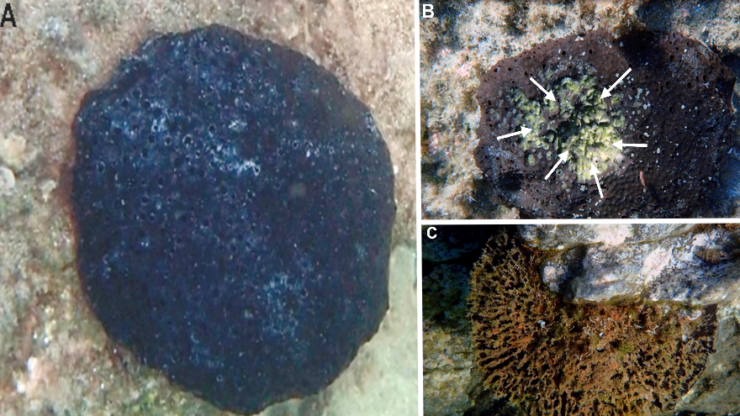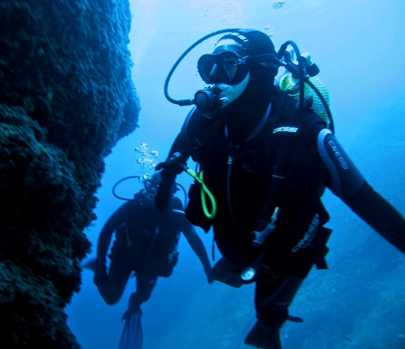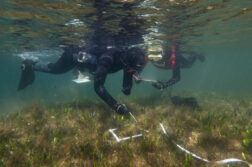In an article published in the journal Frontiers in Microbiology this December 1, CEAB-CSIC researchers demonstrate that, during heat waves, Vibrio bacteria proliferate. These relatives of the microbe that causes cholera in humans play an important role in diseases of marine sponges. They are related to episodes of mass mortality of these organisms.
In 2021, divers on the Turkish Aegean coast observed the mass death of large black sponges, of the species Sarcotragus foetidus. It is an abundant and emblematic species, which was even mentioned in the writings of Aristotle. Researchers have now identified several pathogenic bacteria of the genus Vibrio from tissue cultures of diseased sponges. These bacteria were never detected in healthy individuals. The study cannot resolve whether vibriosis is the initial agent that causes the disease or a secondary infection that ends up killing sponges already weakened by other causes. In any case, the involvement of Vibrio pathogens, which are thermo-dependent microbes that proliferate in warm waters (> 17º C), offers an explanation for the proven fact that mass deaths of sponges increase during the heat waves of the Mediterranean summer.
Vibrio bacteria, named for their vibrating motion when swimming, comprise approximately 150 known species. They are aquatic bacteria that live in fresh, brackish or salt water. Some are non-pathogenic species, but many others are pathogenic for a wide variety of animals, such as fish, crustaceans, mollusks and corals. The best-known member of the group is Vibrio cholera, a freshwater species that causes human cholera. Over the past two decades, Vibrio infections have been implicated in coral bleaching worldwide and mass mortality of edible clams, among other marine invertebrate diseases.
Now, a collaboration between researchers from the Katip Celebi University of Izmir (Turkey) and the Center for Advanced Studies of Blanes (CEAB-CSIC, Spain) reveals that Vibrio bacteria are also involved in the mortality outbreaks of the sponge Sarcotragus foetidus and probably from other sponges. The results are published in the journal Frontiers in Microbiology.
In the summer of 2021, in Izmir (Turkey), Dr. Fikret Öndes – associate professor at Katip Celebi University in Izmir and co-author of the study – had the first news of a mysterious disease that affected sponges locally. “When I dived in the study area, I not only found visibly sick sponges, but also many dead ones” explains Öndes. He immediately alerted his colleagues, with whom he undertook the study. “Given the sudden nature of the disease, the study was started without having specific funding for it and many of the initial research expenses were borne by the personal money of the Turkish scientists,” declares Dr. Manuel Maldonado, leader of the group. of Ecobiology and biotechnology of Sponges from the CEAB-CSIC and co-author of the study.
In various dives between August and December, the researchers studied 117 sponges off Seferihisar, on the Turkish Aegean coast. Each individual was photographed and measured, and tissue samples were taken and used to inoculate specific culture media for bacteria of the genus Vibrio.
“While the tissues of the healthy sponges did not produce bacterial growth in the media, those of the diseased sponges did” says Dr. Ezgi Dinçtürk, a member of the Turkish team. “From the ribosomal RNAs of the cultured microbes, three Vibrio species of known pathogenicity were identified: V. fortis, V. owensii and V. gigantis”¸ explains Dr. Laia Leria, member of the CEAB-CSIC team.

It was known that these species could infect corals, mollusks and crustaceans, but they had never been found in sponges. The first censuses of the incidence of the disease revealed that 27% of the sponges in the population were visibly affected by severe necrosis and 9% were practically dead.
«None of the three pathogenic Vibrio species was found in all the diseased sponges studied. This could mean that vibriosis is a secondary infection that worsens the course of the disease, and not the primary etiological agent,” comments Dr. Maldonado.
Consequences for marine ecosystems
Sponges are organisms that, from a functional point of view, are considered “habitat engineers.” That is, organisms that, with their presence and physiological activity, contribute to creating the habitat in which many other species of organisms live. Therefore, if sponges die en masse, the quality of these habitats deteriorates and many other organisms may die as a result of a cascade effect or, if they are mobile organisms, they may abandon those territories in search of new, higher quality habitats. Sponges create habitat through three ways: 1) their bodies often provide shelter for numerous invertebrates and small fish; 2) sponges filter thousands of liters of ambient water daily, retaining bacteria and microplankton that are suspended in the water and that constitute their main food. This consumption of microorganisms makes the water in habitats where sponges are abundant “cleaner” in terms of suspended particles. This allows light to penetrate to the seabed with less dispersion, facilitating the growth of organisms that depend on light, such as algae, seagrasses (Posidonia, etc.), and even corals, which need light to grow their plants. dinoflagellate symbionts and avoid bleaching; 3) Sponges release inorganic nutrients into the surrounding water, such as nitrite, ammonium, phosphate and others. These nutrients are crucial for the growth of bacterioplankton and other organisms that are primary producers in marine ecosystems. In summary, mass mortality of key organisms, such as sponges and corals, often triggers a cascade of secondary effects that is difficult to predict and quantify, but is generally believed to lead to negative changes (impoverishment of biodiversity ) in marine systems. This topic is currently the subject of numerous studies.
Mass mortalities in the Mediterranean: past, present and future
For more than 100 years, epidemic mortalities of sponges have been detected occasionally. In fact, these epidemics ruined the traditional industry of bath sponge farming farms in the Mediterranean (Greece) and the Caribbean (Florida, USA). During the last two decades, the frequency of these mass mortalities has accelerated worldwide and they have begun to be related to both local heat waves and global ocean warming. However, the mechanisms through which water warming leads to mass mortality of organisms remain unclear in most cases. Although these massive mortalities have been observed in different seas around the world, the Mediterranean seems to be an area especially prone to them. Probably, as it is a relatively closed sea and one of the most studied seas in the world, epidemic mortalities have been detected earlier and their effects are being described in greater detail.
“Our study, which was prompted by the emergence of rapid mortality and lacked specific funding, should be considered a first approach that leaves several important questions unresolved.” Further investigations based on metagenomics of diseased individuals sampled at various stages of the disease will be necessary to resolve outstanding questions. “I would say that the main merit of our study is that it will help raise awareness among spongiologists that vibriosis should begin to be taken into account as an important factor, particularly in cases of mass mortality associated with heat waves”, acknowledges Dr. Maldonado.
In order to delve deeper into the pending questions, the CEAB-CSIC team has recently begun a collaboration with Dr. Lucia Pita and doctoral student Berta Pinto (ICM-CSIC), experts in sponge microbes. The objective is to investigate in greater detail the possible infectious agents that could be the cause of the massive mortality that several species of sponges in the Spanish Mediterranean suffer after the summer heat waves. In this new phase of the investigations, there is also the altruistic support of Eduard Marqués, a member of a citizen network that monitors and warns about changes in marine communities. Likewise, in these future research actions there will also be the collaboration of the L’Aquarium of Barcelona.




